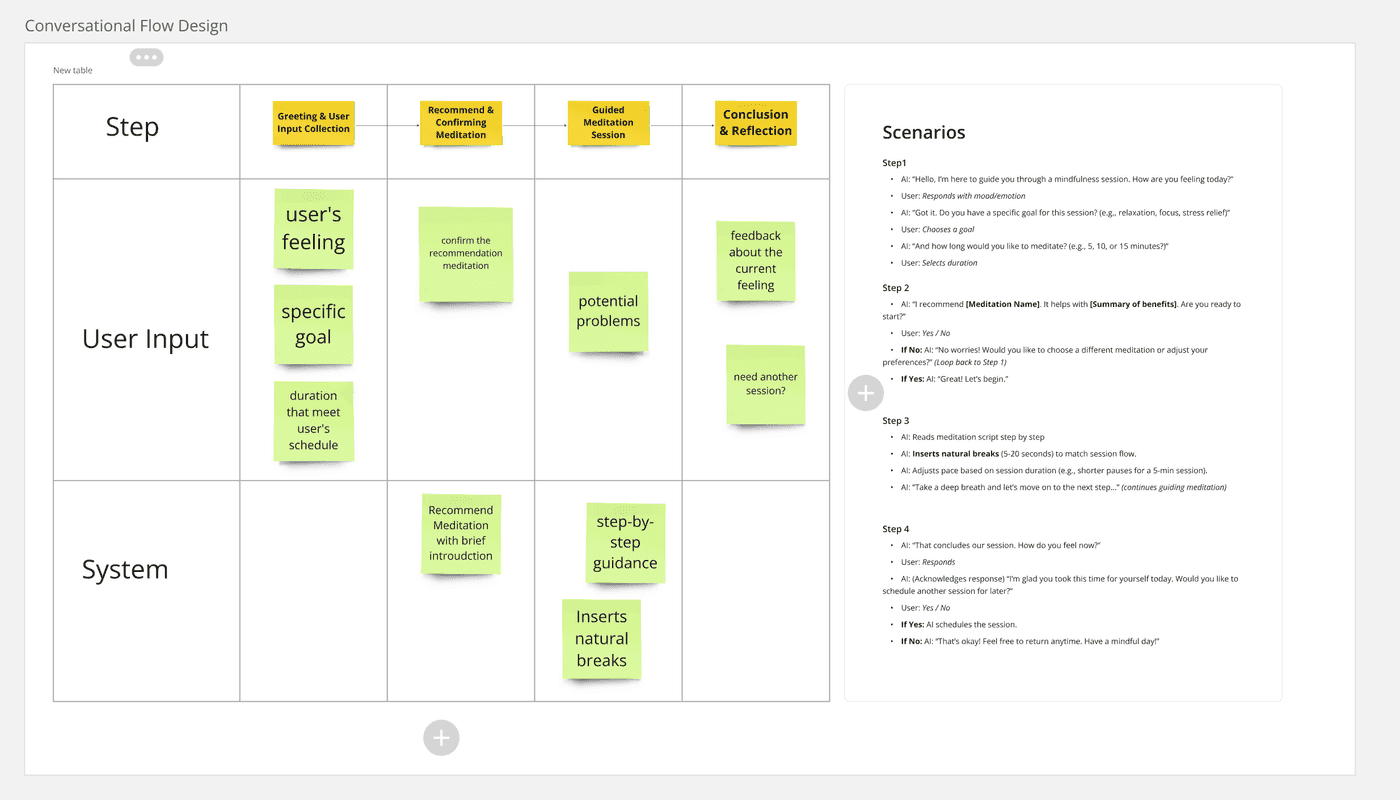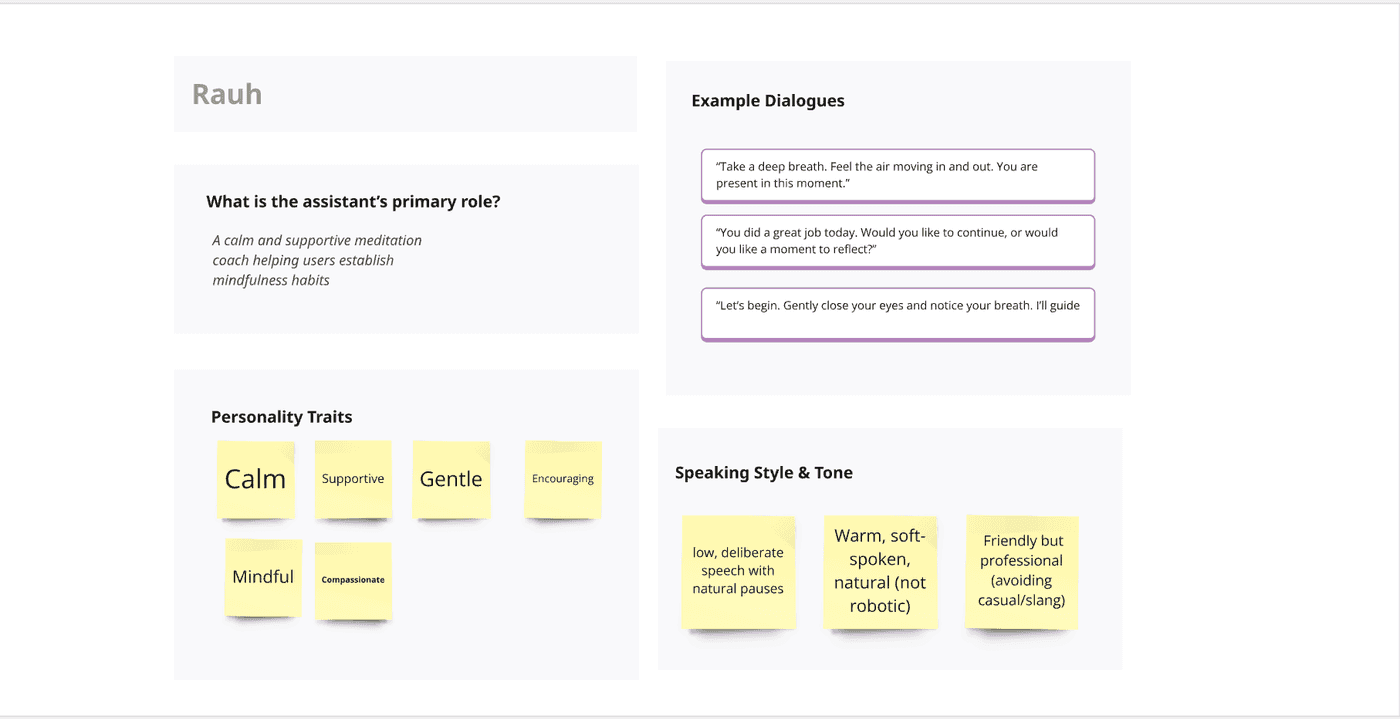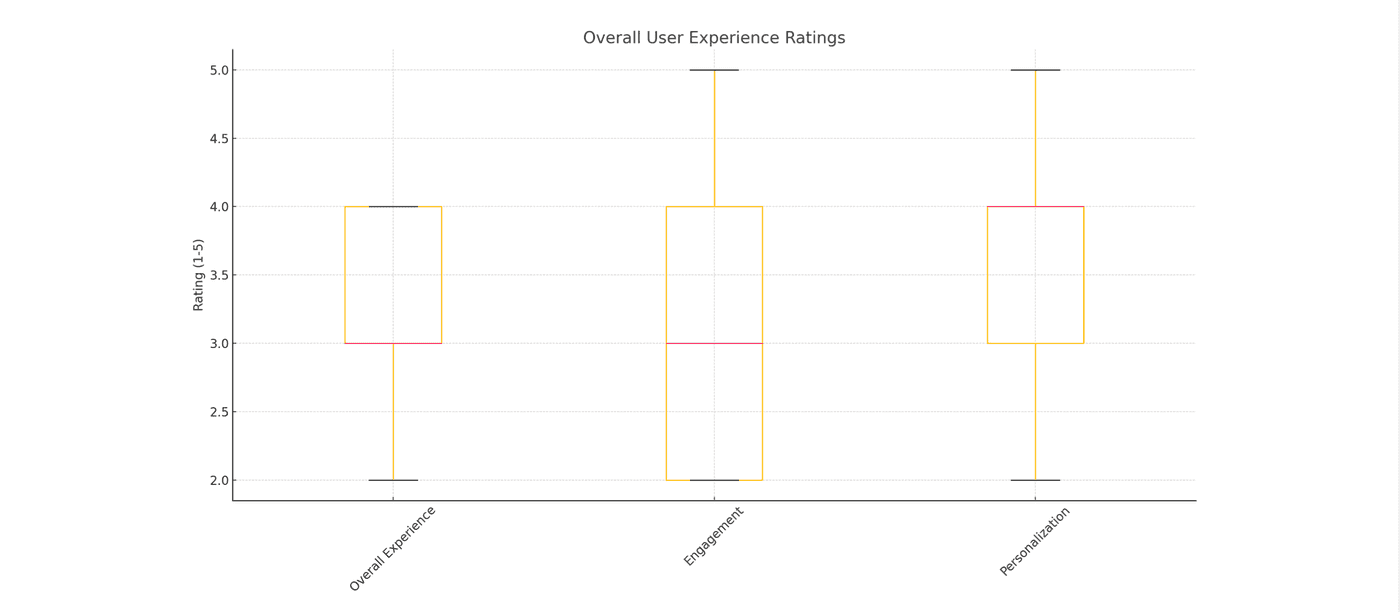Rauh.AI: Voice AI Assistant for Mindful Practice

Context
Overview
This project is a voice-based AI assistant designed to support mindfulness practice by offering guided exercises and personalized feedback. This project was developed as part of the “Conversational AI & Voice Interaction” course, where I explored the principles of designing and evaluating AI-driven conversational systems.
My Role
My role involved UX research, conversational design, and prototyping, focusing on understanding users’ mindfulness habits, designing natural conversational flows, and optimizing AI responses for better engagement. This project explored how voice interface and AI technology can enhance mindfulness compared with traditional meditation approach.
Problem & Challenge
Traditional mindfulness apps often rely on pre-scripted audio, making it difficult to fully tailor to user's need. Many users also struggle with consistency and need real-time guidance. Voice AI presents an opportunity to provide hands-free mindfulness coaching, but designing an intuitive and non-intrusive voice experience remains a challenge.
How might we create a voice AI that enhances mindfulness without adding cognitive overload or disrupting the meditative state?

Research
To gather insights on how voice AI can enhance mindfulness and meditation experiences, we first conducted a secondary research including investigating user needs, best practice in voice UX for meditation apps, cognitive science behind mindfulness and ethical considerations. The sources include ACM digital Library, IEEE Xplore which related to voice AI interaction, conversational UX and mindfulness practice.
- How can voice AI effectively guide meditation to reduce stress and improve well-being?
- Which voice design principles are most effective for mindfulness experiences?
- How do existing meditation apps and AI assistants implement voice-based guidance?
We also conducted an online user survey with 9 participants (22 - 39 years) to to explore pain points in traditional meditation apps and assess the potential benefits of AI-driven guidance.
Key Findings
- A soft, slow-paced, and natural voice enhances the meditation experience.
- Eliminating screen interactions allows users to focus on breathing and body awareness.
- Tailoring session length, pace, and difficulty improves adherence.
- Simple check-in prompts like “How are you feeling right now?” strengthen user engagement.
- Voice AI should include clear disclaimers to prevent users from mistaking it for clinical therapy.
Our UX design for the voice AI assistant was guided by key research findings, prioritizing a warm, natural-sounding voice to enhance relaxation. We designed a hands-free, voice-first experience with minimal user prompts to reduce cognitive load, while integrating adaptive session recommendations and real-time personalized prompts to improve engagement. Instead of relying on static pre-recorded scripts, we implemented dynamic voice responses for a more interactive experience.
User Group
Our target users can be categorized into two main groups:
- Beginners Seeking Stress Relief, who are new to mindfulness and need structured, easy-to-follow guidance to manage stress and anxiety.
- Regular Practitioners Looking for Personalization, who have some experience but struggle with repetitive content and seek AI-driven recommendations tailored to their moods.

Design
Conversational Flow Design
This conversational flow was designed to create a seamless, adaptive, and intuitive voice-guided meditation experience. The interaction follows a structured yet flexible four-step process.

For misunderstandings and no response situations, the voice AI assistant also need to consider graceful fallbacks (e.g., “I’m sorry, I didn’t get that. Could you rephrase?”) or enable user to pause or researt the practice session if error happens.
Personality & Tone
We created an AI persona which also acts as a foundational reference for prompt design, ensuring a coherent and immersive user experience

Prototype
To validate our conversational flow and user experience, we built a working voice AI prototype using rapid prototyping tools that enabled real-time interaction, natural speech synthesis, and personalized guidance.
Technology Stack & Rationale
To quickly build and iterate the prototype, we leveraged AI-powered APIs and frameworks designed for voice-first user interactions: OpenAI Assistant API, OpenAI Whisper, Text-to-Speech API (ElevenLabs), Next.js.

-
💡 Challenge 1: How to ensure natural voice pacing for meditation?
✅ Solution: We selected a pre-trained ElevenLabs voice optimized for calm speech, reducing robotic tone. -
💡 Challenge 2: How to create realistic pauses during guided meditation?
✅ Solution: We leveraged OpenAI Assistant’s function calling feature to insert 5-20 second adaptive pauses, aligning with different session lengths. -
💡 Challenge 3: How to avoid misunderstandings in voice interactions?
✅ Solution: After testing, we found OpenAI Whisper’s high-accuracy ASR helped recognize user input reliably, reducing errors in meditation session selection.
Final Deliverables
- A fully functional voice AI prototype that allows users to select a meditation session, receive voice-guided prompts, and interact naturally.
- Voice-first interface, eliminating the need for a visual UI during meditation.
- Hands-free experience with adaptive voice responses, natural pauses, and real-time engagement based on user input.
Testing
To assess the effectiveness with the prototype, we conducted usability testing with 9 participants (ages 22-39, mixed experience levels in mindfulness practice). The goal was to compare the experience of AI voice-guided meditation versus traditional audio-guided meditation and identify areas for improvement.
Key Insights
Personalization was a key advantage of the AI-guided meditation experience, with 55.6% of users preferring it over traditional pre-recorded sessions. Participants appreciated the AI’s ability to dynamically adjust session length and provide tailored recommendations based on their input, making the experience feel more customized and responsive to their needs.

Challenges with AI Guidance
While personalization was valued, several areas for improvement were identified:
- Some users found AI guidance unnecessary mid-session, preferring fewer interruptions.
- Technical inconsistencies (e.g., session durations were occasionally misaligned with user selections).
Opportunities for Future Improvement
The findings provide a roadmap for future enhancements:
- 💡 Minimizing mid-session interruptions while maintaining personalization.
- 💡 Improving session length accuracy to match user selections.
- 💡 Expanding customization features (e.g., background sounds, silent meditation options).
Outcome
🎯 AI Personalization Solution Shows Promise
Working in a multidisciplinary team with another student studying data science for this project, I built the Rauh.AI prototype, which demonstrated the potential of AI-driven voice guidance in mindfulness, offering personalised session lengths and adaptive recommendations. User testing showed that 55.6% of participants preferred AI meditation to traditional audio-based guidance due to its personalisation features.
💎 Better Understanding of Challenges in Voice AI Interaction
Despite the benefits of personalization, feedback revealed areas for improvement. Mid-session AI interruptions and an overly directive voice tone reduced immersion for some users. This highlighted the need to refine the AI’s presence—transitioning from an instructor-like role to a more passive, supportive guide that enhances relaxation rather than directing it.
Takeaways
✨ Balancing AI Engagement & User Control
This project reinforced the importance of striking a balance between AI interactivity and non-intrusive guidance. Users valued personalization, but giving them more control over AI engagement levels could enhance the experience further.
🚀 Refining Voice & Seamless Integration
The effectiveness of voice AI in meditation depends on pacing, tone, and interaction flow. Future improvements should prioritize a more natural voice presence, reducing friction points such as unnecessary interruptions, and ensuring ethical considerations—especially in wellness applications where AI must remain a facilitator, not a substitute for professional guidance.